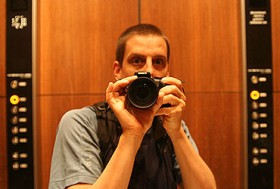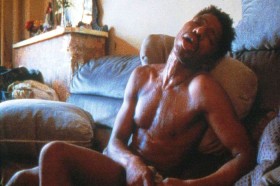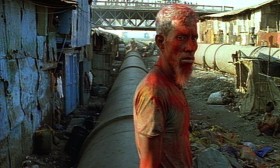


Glawogger and Novotny
At DocsBarcelona 2013 Michael Glawogger asked me if I could write a piece on ”Megacities” and the remix of it done by Timo Novotny, ”Life in Loops”. Compare the two, he said, and he gave me the dvd’s of the films, that I knew very well and admired. I sent the article to Michael, he thanked me, wanted to use it in a book on ”Megacities”. I did not hear from him and now it’s too late to ask him what happened with the book project… Therefore, as a tribute to a great filmmaker’s work and generosity towards a young colleague, here is the article:
It was at the Ex Oriente workshop in 2004/05 that I met Timo Novotny and ”Life in Loops”. He presented this original idea to dive into the film ”Megacities” by Michael Glawogger, tear it to pieces to make his version of a work, that already at that time was considered to be a neo-classic in modern documentary.
He talked for hours about how and why. And to all of us, whose first question was ”do you have the permission”, he stressed, that Glawogger had given him access to use the 40 hours of material that he had shot in Bombay, Mexico City, Moscow and New York. And that Glawogger had no intention to interfer in the remix, the word Timo used, of the material. It was the first time I had heard about such a generous attitude from a director with an international reputation.

Timo Novotny
It was, however, all words that the young director came up with to promote his first feature documentary and it was not before Timo had shown his fellow workshoppers a visual teaser for the film that he wanted to make, that it was obvious what he was aiming at. He showed exceptional talent in the way he had put sound and image together, not to forget the crucial collaboration with the music group Sofa Surfers. The group provided music far from normal film music, it was something new and the combination of the image and the soundtrack seduced the viewer.
Correction: Most of us were seduced. When it came to the obligatory pitching session, where broadcasters were present to react to what they saw, enthusiasm was quickly mixed with scepticism. Timo was met with ”can you say that it is your work when you intend to take it all from an existing film”, ”who wants to watch a music video for 90 minutes” and ”is this a real documentary film”. Or ”why a new film when we already have ”Megacities”.
No tv-station dared to invest in a film that was fresh and new in approach, with great images and an editing rythm one could imagine to be appealing to the young audience that was the target of Timo. A style that could/ought to be interesting or public broadcasters, who were/are chasing young people, who were/are fed up with boring traditional television? On the bonus track of the ”Life in Loops” dvd there is a conversation between Glawogger and Timo, where the latter very often comes back to the disappointing reception of the film at many festivals:
Where (some) ”serious” critics characterised the film as a piece of ”recycling”. In the same dvd there is a booklet where the director proudly states that the film reached 43 festivals in 18 months. Not bad at all. So the film actually got its international carreer.
For me the scepticism comes down to the eternal conservatism that also met Michael Glawogger. There is a decade between ”Megacities” (1997) and ”Life in Loops” (2006) but the discussions around the two films are more or less the same, linked to the same basic questions:
What is a documentary? What can a documentarian allow himself to do? Can he set up/stage scenes, don’t you lose the authenticity and what about the ethics, don’t they exploit poor people in ”Megacities” and consequently in ”Life in Loops”?
I have been involved in documentary promotion and distribution since the mid-1970’es and these questions have come up all the time, and still comes up whenever a director crosses some borders that state what you can do and what you can not do. Even if these rules are not written anywhere. But they exist anyhow, and I suppose this was the reason that Werner Herzog at some meeting in the US attacked the cinema vérité in the hall (Maysles, Leacock, Drew, Pennebaker) for their constant belief in the observational documentary as the only way. Herzog was maybe unfair to the old boys, but right it is that their influence on the ”poetics” of the genre has been immense.
Luckily it is my impression that the objections mostly come up among professionals, whereas an ordinary spectator does not care but watches and enjoys a story, a film and expects a truthfulness, whatever way the film has been made.
If you read the booklet that follows the dvd version of ”Megacities” (or listen to the audio of Glawogger on the bonus track of the film) (wow, they are good, the Austrians in making dvd’s of high quality, rich in extra material), Glawogger, as Timo, tells about the criticism he got in hour long discussions after the screenings. The comments went primarily towards the ”controversial” scenes with Cassandra in Mexico, Tony the hustler in New York, as well as there were reactions to the dog fight scene and the slaughtering of the chicken dying in their own blood. The scenes themselves provoked, I guess, and they are hard to watch, but the provocation came maybe more in the following debates, where the director told how he staged the scenes.

Cassandra

Tony
Staged… it is still a controversial point in documentary filmmaking, isn’t it, even in times where more and more films are put into the category ”hybrid”. The argument is that you lose the truth in scenes and what is the viewer to believe? The observational style is still God in the documentary genre and tv stations hesitate to broadcast material that is staged, in their documentary slots. They do so on behalf of the viewers… It is common that a disclaimer is put in the beginning of the film to tell the audience that many scenes are staged, even if the audience is not told that the documentary (in this context = the observational) parts are also built up according to many choices. It is of course, at the end of the day, the relation between viewer and filmmaker there is a stake. I like the sentence of Glawogger in the booklet: I’ve never shot anything I have never seen. And another one on the staged scenes: they played it for me, partly true, partly untrue.
More than 15 years ago Glawogger had to explain his method again and again, and why it was the only way to get close to the hustler Tony, who actually ”offered” him the acted scene, where he is robbing a client in a hotel room. Cassandra’s performance, Glawogger tells in the booklet, was arranged and there was free entry for those, who wanted to come and thus take part in the filming. Music was chosen by the director.
For Timo in 2006 these discussions have probably been the same with the addition that he has not made an independent film, but has been ”vampiring” another director’s work.
Documentaries have never been so popular, as they are now, is what I am saying again and again at workshops, where I am adding that ”this is a golden age of documentaries”. It is not big amounts of people, who go to the cinema to watch documentaries, but the numbers are growing, as are the festivals for the genre.
”Golden Age”… with that I mean that documentary films do not limit themselves stylistically, they take from all shelves so to say (hybrid films they are called, a mix of documentary and fiction) which was actually, what Glawogger did in the mid-90’es with ”Megacities” and what he states in the bonus material: ”filmmaking is so rich and the limitations don’t make sense”. This attitude was of course also the motivation that led to the generosity of Glawogger towards Timo – ”go ahead, use the material, I find it intriguing” – words to that effect.
When Glawogger saw what Timo had done to/with his film, he said that it was great to watch the material again, to return to a film, that he had left long time ago: Once a film is made, you pack it away, with ”Life in Loops” it came back to me.
It is my belief that both films when they are screened today (and hopefully they are, they are not outdated in any way, on the contrary) create less controversy about style and staging/not staging, whereas some scenes will still cause the same tumult as in 1997 and 2006.
Sooo, are they different the two films? Yes, indeed.
Are they both what you would call authored films? Definitely!
Do they differ content-wise, yes and no. Take the ”No” first – both films are naturally about life and people in megacities, both stay more or less long with some characters, both have the same great cinematography. It was a scoop for Timo to have Wolfgang Thaler as d.o.p. to film his ”extra” megacity Tokyo and thus bring the same vision to ”Life in Loops” as he did with Glawogger in ”Megacities”.
And here comes the first ”Yes, they are different”, Tokyo, that for most of us Westerners stand for the future with its skyscraper architecture and its super-modern transport means.Timo is crazy about trains and tunnels and metros (as you can see in his newest work, ”Trains of Thoughts”), and it is at a metro station that his (my words) ”tragic hero” is introduced. He is a young man with a headset waiting for the train, totally in his own world on his way home to live in another world, the virtual ”manga culture”, illustrated pornographic comic books, that satisfies him in his small room full of hard drives and ”girl pillows” that he sleeps with. He is not interested in real-life girl friends.
Through this Timo walks in the footsteps of Glawogger, who asks his characters what their dream in life is. In this case Timo has found a character, who points to a new world that we can not imagine – and I can not imagine Glawogger include someone like that in his film.
Glawogger went to the old world, to cities we knew someting about in beforehand poor people, to people who survive whatever tough conditions life has offered them. That sentence sounds like he has made another social documentary, thematically, and the film does give an impression of the world we live in, but Glawogger is never sentimental or a message bringer. He never asks the viewer to feel pity, on the contrary he looks for the dignity in the characters and their surroundings. He carries with him a true curiosity and interest in other people, it is as simple as that. And he offers his viewers to look with him. When he writes – again in the dvd booklet – that his film is about the beauty of people, you can only nod, yes that is what it is about. The universal stamp that he wants to give the film is marked by the many cuts from one city to the other, he calls it himself on the bonus track ”connection points”. ”12 Stories of Survival” he calls his film as a subtitle to ”Megacities”.
A paranthesis connected to ”people” … in a workshop in Barcelona this year Glawogger told me about what he calls ”the guessing game”: You sit in a bar or a restaurant or on a bench in a park and you see a couple in front of you. You start chatting with your companion about them. Who are they, what do they do, what is their profession, is it a good marriage, are they faithful to each other, will it last etc. I am sure that many readers of this have done the same, inventing/writing scenes out of reality?
Back to Timo and ”Life in Loops”. Apart from the Japanese, he chose to build his film around the junkie/hustler from New York, the stripper (Cassandra) in Mexico City, the factory worker in Moscow and the dye worker in Bombay (the one Glawogger calls the multi-coloured man).

Dye worker
His composing skills are evident from the very beginning. The first 8 minutes before the title of the film appears can be used in every film school to say how to catch the attention of the audience. ”Run nigger, run” the man sings in front of an abandoned house, the rythm is there to accompany the radio host’s invitation to people to call him and say how they survive in the city. There’s split screen, fast editing, image manipulation and the themes are introduced: racism, prostitution, who are running that business, begging, hustling. New York, New York, who will not be fascinated by this intro to the overall theme of ”Life in Loops”: Survival. I showed the film at a film school in Italy, Zelig it is called, and pretty many of the students kept on saying that they wanted to make a film like ”Life in Loops”.
A bit later, Akbar Ali, the dyestuffer, the multi-coloured man. Timo plays with his face and the colours, fast editing, at a moment you think that he is not really interested in the man but then he stays with a close-up on him for a long time and your thoughts change, he is not just an object. And the sequence goes on to let us see how the cloth is handled at the big outdoor washing sinks, fabulous shots. Glawogger must have been happy to see that used. It was not in ”Megacities”.
Form is very important for vj Timo and his Sofa Surfers. The female factory worker in Moscow is a perfect example. With the editing and the music this is an amazing sequence with its focus on objects, production of elements to be used for, yes for what?, not important, with weekdays noted on the screen and with her turning to the camera saying her name and her dream in life – you are taken back to old Soviet silent propaganda films, an homage to the industry and the worker. But in ”Life in Loops” you don’t go home with the worker, you don’t see her reading for her daughter as in ”Megacities”, where Glawogger builds his Russian sequences around people reading in the metro and with a hard core sequence from a jail, where drunkards are brought in to stay for a night, hand-cuffed some of them. Glawogger knows his Dostojevsky!
On the dvd-bonus track Glawogger comes up with interesting comments on the drunkard sequence: In this scene you are outside (the door to where they are placed on beds), it shows where you belong (as a documentarian), outside. To be noticed, and as a compliment, Glawogger surprises us by cross-cutting to many Russian women, who individually sing a song about what to do with their drunken husbands. Yes, he surprises us through all the film with new ideas and subgenres, here it is the musical that enters the narrative structure.
Cassandra. The stripper who performs her show letting the men get close to her, touch her, suck her here and there, while she piece by piece undresses on the stage. Glawogger chose the music for the film and advertised the performance to have the men come in for free to take part in the film. He lets us see the woman at home with her children, it is important to understand her family situation, we go with her to the performance, back again and to the show again. Lots of people find that the director exploits her, I don’t get that thought, but the performing scenes are hard to watch and of course you can only hope that she manages to get the other life that she talks about to the director. Maybe this is the reason, the hardness of these scenes, why Timo in ”Life in Loops” has chosen to create a distance to Cassandra on the stage. He does so through double/triple exposures of her dancing. He brings in a feeling of attending a ballet, with Cassandra in two, three, four versions mixed with some beautiful shadows.
Timo is an aesthete and his fascination of lines and forms is in general brilliantly conveyed through the montage of images, words and the music of the Sofa Surfers. Music that flows and is synergetic with the image in pulse and rythm, contrary to the mainstream use of music in documentaries of today, where music is poured on like sugar to strawberries to hide a lack of energy in the sequences.
The search for beauty in form is also – to come up with an understatement – present in the scene with the cock fight that Glawogger did not use. It goes on and on, for a long time, that is what you feel, too long time until the moment where you watch something that – if you could stop the image – could be framed and hung on a wall as an abstract colour painting.
Glawogger, on the other hand, invites us to look at a dog fight or at chicken industry slaughtering. ”I force people to look at it”, he says on the dvd bonus track, indeed he does force, and it is tough. It is interesting that he on the same track keeps on saying that many scenes could have been longer, actually he says ”every scene is worth a longer look”. He wants us to see the world in all its beautiful complexity, whatever continent he has been to, this is the message conveyed to us indirectly in a never sentimental tone.
I would like to quote what I see as Glawogger’s lovely tribute (taken from the booklet) to documentary filmmaking and travelling and curiosity and interest in fellow citizens of the world:
For me documentary filmmaking is a very special kind of life and I come to see places in a way that I could not see by just travelling, and I would also feel lost travelling without the purpose of watching things in order to work with them, since that makes sense to me. If I weren’t a filmmakers, I wouldn’t take that time for travelling and watching, so that makes me very happy. The people I meet for these films, that makes them very happy…
I think Timo has more or less the same approach, working with a different style, but already now he has his own handwriting as the film ”Trains of Thoughts” clearly shows. There is one scene towards the end of ”Life in Loops” that is second to none, where he interprets Glawogger’s romantic intention in a playful montage: The old Mexican couple that cooks at home, sells the food in the street, dances at home and in a ”glamorous” (Glawogger’s words) dancing hall. Here form and content go wonderfully hand in hand, carried by Sofa Surfer music. Magic.
Two classics in modern documentary. What a pleasure!